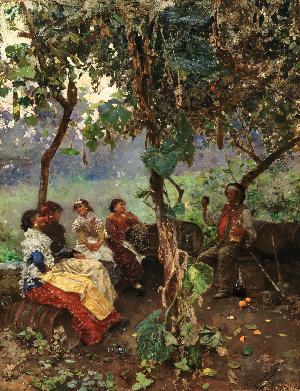SANTORO RUBENS
MONGRASSANO (CS) 1859 - NAPLES 1942
Born in Mongrassano (Cosenza) on 26 October 1859 by his father Giovan Battista, painter and sculptor, he learned the first elements of art. Once his family settled in Naples, the young man was able to cultivate his natural inclination to painting, attending the Institute of Fine Arts for just one year, then studying directly on the truth, and traveling continuously. In 1875 he presented a picture at the Venice Exposition, A girl who laughs, which was awarded a silver medal and purchased by Domenico Morelli. Since then he has been noticed at numerous exhibitions with genre and marine paintings, in which his qualities as an effective colourist, worthy heir of the glorious Neapolitan school can be admired. Among the numerous works by him are cited: A balcony; Impression; Marina alla Chiaolilla in Procida; Sole di Marzo and Case di Procida (these two bought by comm. Gerolamo Maglione): all exhibited at the exhibitions of the "Salvator Rosa" promoter of Naples, in 1874 and 1876; Marina di Maiori and A Music Lesson, presented at the National Exhibition held in Naples in 1877; The cave of the gypsies, sent to Paris in 1878; Oldness; Marina of Naples; Youth; Well; The gypsies; Overpass; Monte Tiberio and Quiete: all presented in Turin at the National Exhibition of 1880; five paintings of Veronese subjects: In San Zeno; Adigetto; Via Scala; Stallo and Riva San Lorenzo, with whom he participated in the 1884 Exhibition in Turin, which also featured his sketches Veneziana and A Napoli. Then the paintings: Ruins, purchased by Rocco de Zerbi, and Una scala, presented at the "Salvator Rosa" of 1887; Art channel in Venice and Algerian smoker, sent in 1888 to the International Exhibition in Paris; Interno and Pescarenico, exhibited in Palermo in 1891-1892: the latter painting awarded with a gold medal and purchased by King Umberto I; In the Bay of Naples and Zingari, with whom the artist participated in the Colombian World Exposition held in Chicago in 1893; Posillipo, presented at the "Amatori e Cultori" exhibition in Rome in 1895-1896; Sta-gnatorì Neapolitans and Palazzo Vanaxel in Venice, sent in 1896 to the Paris Motor Show; Meditation in Capri, presented the following year also at the Salone; A canal in Venice, in Turin in 1898; Verona (watercolor), in Paris in the same year; Zingari and Veduta di Posillipo, with whom the artist also appeared in 1898 at the Italian Exposition in Leningrad; Canale della Latta (Venice); Verona; Gray weather in Venice; Twilight in Venice: all exhibited at the Parisian Salon between 1904 and 1909; Canale grigio and Casamicciola, purchased by the Spanish Consul, presented at the 1910 Venetian Biennale; A canal in Venice, sent to Buenos Aires at that International Exposition held in the same year; After the rain and The ancient chapel of San Benedetto, exhibited in Rome in 1911, on the occasion of the Cinquantenaire Exhibition; Verona, awarded with a silver medal at the Barcelona International Exhibition in the same year; Without family, exhibited in 1924 and purchased by the Municipality of Reggio Calabria; The two dolls; Cloister of San Zeno; Scaliger arches; Portrait of Francesco Cilea; Costa del Tirreno, donated by the artist to his native town; Portrait of the Duchess of Aosta; Idyll, in the Civic Museum of Turin; Golden hair, donated by the author to the late Queen Mother; Bedouins in the desert. Many of his paintings appear in collections in Italy and abroad. Currently the Santoro occupies the place already held by Domenico Morelli in the Neapolitan Institute of Fine Arts.
©2015 ENRICO Gallerie d'Arte - All Right Reserved - P.IVA 00985970094 | Privacy Policy | Cookie Policy | Site Map

